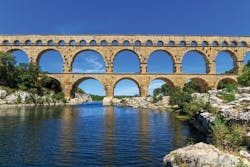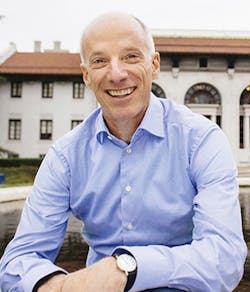Water 4.0
How the historical development of urban water systems can inform the water distribution channels of today
By Paul O’Callaghan
David Sedlak is professor of civil and environmental engineering at the University of California, Berkeley, and his research has focused on chemical contaminants and the development of sustainable systems to manage water resources. Following interactions with the general public over the introduction of potable water recycling, he was moved to write Water 4.0: The Past, Present, and Future of the World’s Most Vital Resource on the historical development of urban water systems.
“I have a background as an environmental chemist, and in the 1990s I became interested in potable water recycling and whether the process posed a risk to human health,” Sedlak said. Talking to utilities and members of the public, Sedlak discovered “there was so much misunderstanding and there didn’t seem to be any place people could find out how [water recycling] worked.”
The first phase of water infrastructure was developed to import water, like this striking Roman aqueduct which brought water to the city of Nîmes in southern France.
What he discovered through his deep dive into the history of urban water systems was that solving problems in water infrastructure was not a story of incremental change and development but rather one of rapid catch-up when the problems became too big to ignore.
“To solve today’s problems, you need to know where the infrastructure we have comes from and the regulatory background that brought it into being. It is enlightening to see the ways in which decision makers have been constrained in the past and how this has led to cycles of crisis and investment. Seeing the connection between this past and our current situation made me decide to explore this,” he said.
The title of Sedlak’s book refers to the fact that urban water systems undergo periods of rapid change, resulting in a new system. He determines that the most developed countries have gone through three changes and are on the cusp of the fourth — 4.0.
“The first phase was imported water systems,” he explained, “and this can be traced to ancient Rome and earlier civilizations. They picked up steam during the Industrial Revolution in cities like London and Paris which expanded to over one million people.
“They dug canals, built aqueducts and developed gravity-fed infrastructure that formed the basis of cities around the world.”
UC Berkeley Professor David Sedlak.
Sewage Systems
Sedlak explained that this first version of water sowed the seeds for the next. Instead of being used only for basic drinking and hygiene purposes, water was soon being used for flushing toilets and filling baths, and consequently large quantities of sewage were entering the waterways via storm sewers and ditches.
“Typhoid fever and cholera reached epidemic proportions and a large part of the problem was untreated sewage in waterways,” said Sedlak. “Sand filtration and chlorination were introduced, which made it safe to drink sewage-contaminated water and every city began building water treatment plants.”
The next revolution in water technologies was the response to public concerns about surface water contamination that became progressively more severe as cities grew in the twentieth century. When sewage and other toxic substances enter lakes, streams, rivers and oceans they dissolve or lie suspended in water, resulting in pollution.
“It was in the 1970s that we got serious about the problem,” Sedlak noted. “Countries in the developed world spent billions upgrading wastewater infrastructure and waterways became safe to fish from in Western Europe, but this hasn’t yet happened in other parts of the world.”
Water scarcity
Which brings us to the emerging fourth revolution and another period of large investment and rapid change. “There are two drivers — water scarcity and changes in urban drainage,” said Sedlak. “Most attention is focused on water insecurity — expanding populations and climate change and competition for water resources.
“Providing water by importing is no longer as reliable. We are seeing different kinds of investments from the recent past: water recycling, seawater desalination and stormwater harvesting.”
Sedlak pointed out that Southern California is one of the places that best illustrates the trend, especially the cities of Los Angeles and San Diego, which are both water-stressed. With the Colorado River basin drying up, levels in reservoirs are falling and predictions point to the disappearance of snowpack in the western U.S., which means long-trusted water supplies are becoming less reliable.
Southern California has been moving toward alternative water supplies for a number of years. Potable water recycling — where water is returned to the aquifer as groundwater recharge after advanced wastewater treatment — is already taking place.
“Another example is in Orange County,” said Sedlak, “where all the sewage produced is recycled and the water returned to the aquifer instead of being discharged to the ocean. The success of this program has encouraged other cities to do the same.
“Seawater desalination has also seen growth and over the last two decades the costs of building treatment plants and of energy consumption have both come down. Cities in Israel have a strong uptake and the approach is gaining more interest in Southern California, for example in Carlsbad — which has the largest desalination plant in the western hemisphere, processing 200 million liters per day.”
Stormwater Harvesting
Urban stormwater harvesting, however, is proving more challenging to implement, especially in Southern California where the hydrology is not favorable due to the relatively small number of storms.
“Stormwater capture can help alleviate risk of flooding and pollution, so it is worth finding ways to capture the water,” Sedlak said. “We need to start thinking of water supply and wastewater and stormwater together, not separately, so more opportunities to work together emerge and a greater uptake of technologies [occurs].”
It’s going to come slowly, he observed, “because there are plenty of cities where water supply is adequate. In the rapidly developing world it’s a different matter — they may leapfrog directly to seawater desalination or potable reuse if they can afford it.”
Distributed Water
Another emerging trend in new water sources is distributed water systems, which take care of water at neighborhood, street or even household level, keeping water within a specific locale.
“In San Francisco, an ordinance states that water-recycling systems must be built into new skyscrapers and condominiums, which makes a considerable impact on water footprint. In Bangalore, India — which is struggling with sewage treatment and water supply — they are pushing building-scale sewage treatment.”
However, Sedlak warned, when office parks and wealthy communities take care of themselves, even recycling their own water, “the risk is that resilient and adaptable distributed water infrastructure may be restricted to the rich people who can afford them.”
Technologies for potable reuse, seawater desalination, stormwater capture and distributed water “already exist and are becoming cost competitive,” he noted. In addition, in cities where water conservation has not been adequately pursued, “that may be the least expensive approach.”
Barriers to water recycling still exist and fall into two main camps: institutional and regulatory. Connecting with the historical record, Professor Sedlak observed that in the early days of water recycling there was regulatory concern about public health where the source was sewage.
“It took time for elected officials to change public perceptions. Once those were resolved, it was much easier to permit projects. It is the same for stormwater capture and desalination, it takes a little more time to get them built.”
The second barrier is financing and investment. Public utilities usually have budgetary constraints and projects using new technologies come with a certain amount of risk.
“Early adopters tend to be wealthy cities with few other choices. Technology diffusion is how new technologies come into practice and it can be a decades-long process based on a combination of good luck and sound engineering,” said Sedlak.
“The water industry, unlike other areas, is not a ‘me first’ proposition, it’s a ‘me too.’ Identifying early adopters and working through pilot projects lowers risk. What determines whether a technology fails or succeeds is the commitment of researchers and developers — and building trust and confidence throughout the process.”
Making Connections
Sedlak noted that whenever he’s around a group of people there’s the potential to gain perspective on a shared interest. “The technologist needs an investor; the regulator needs new technology and another way of doing things,” he said.
“Through engagement you get a better sense of the way decision-makers are making selections and tackling problems facing water providers. You also learn which technologies are on the horizon and that helps advance the technology ecosystem.
“We have to remember every city has different needs in terms of the geography and culture that support its water system,” he advised. “By sharing experiences we see the tools or the palette available for creating a secure water supply.” WW
Author’s Note: Professor Sedlak will give the keynote speech at the BlueTech Forum at Kew Gardens, London, UK, June 5-6, 2019. Learn more about the BlueTech Forum at www.bluetechforum.com.
About the Author: Paul O’Callaghan is founder and CEO of BlueTech® Research, a consultancy that provides investors, water companies, researchers and regulators with the latest information and analysis on emerging water technology market areas.
Circle No. 251 on Reader Service Card


